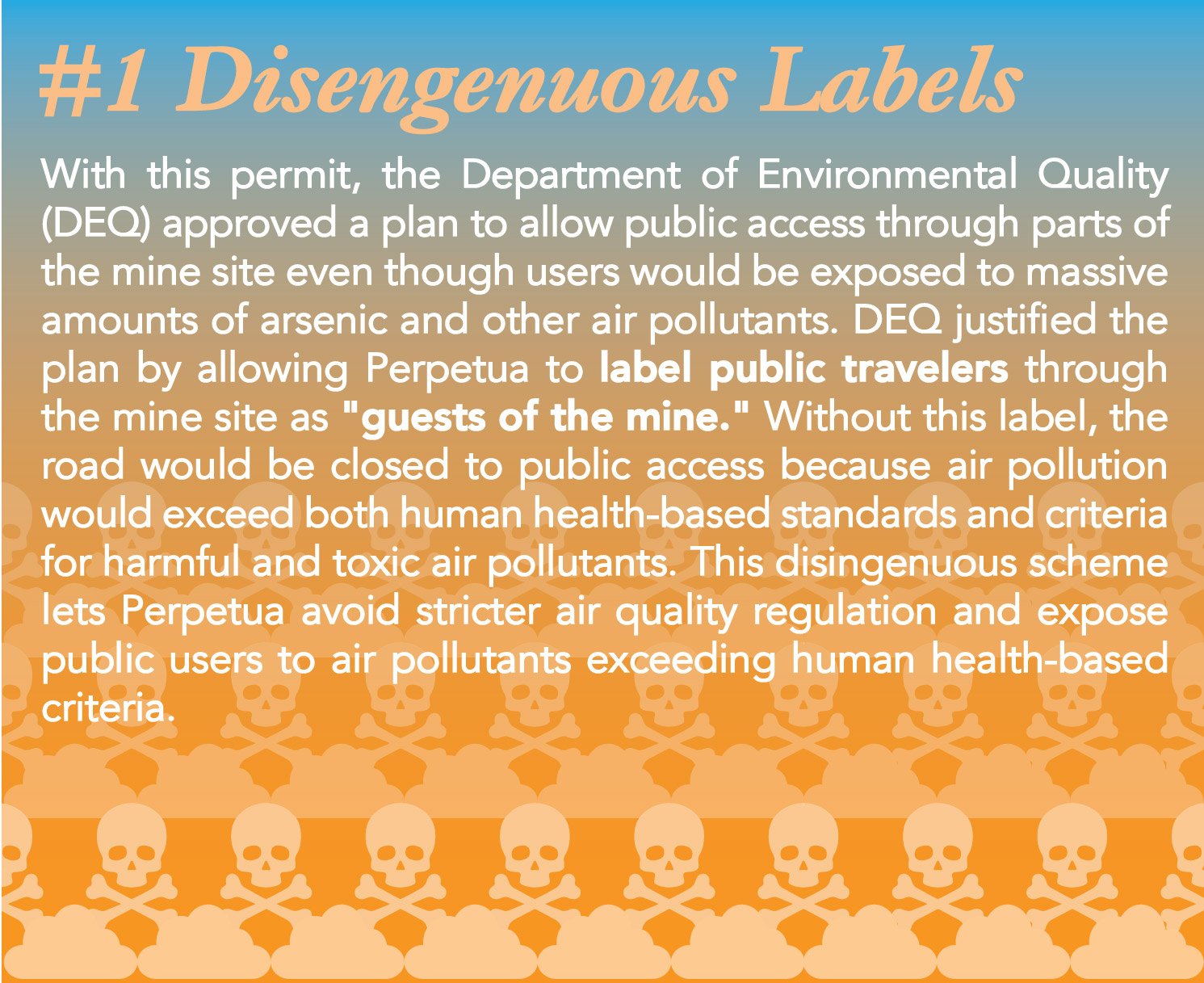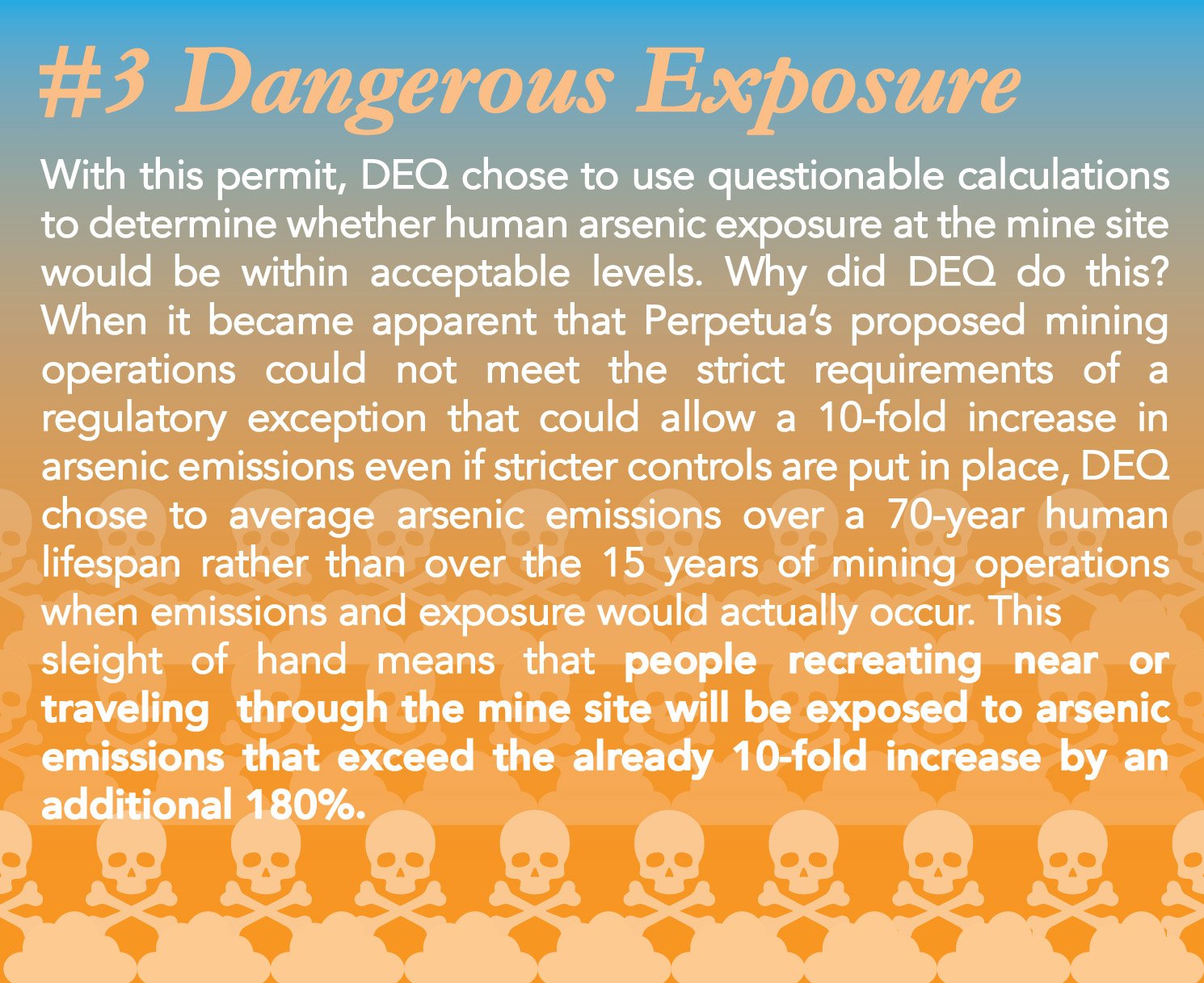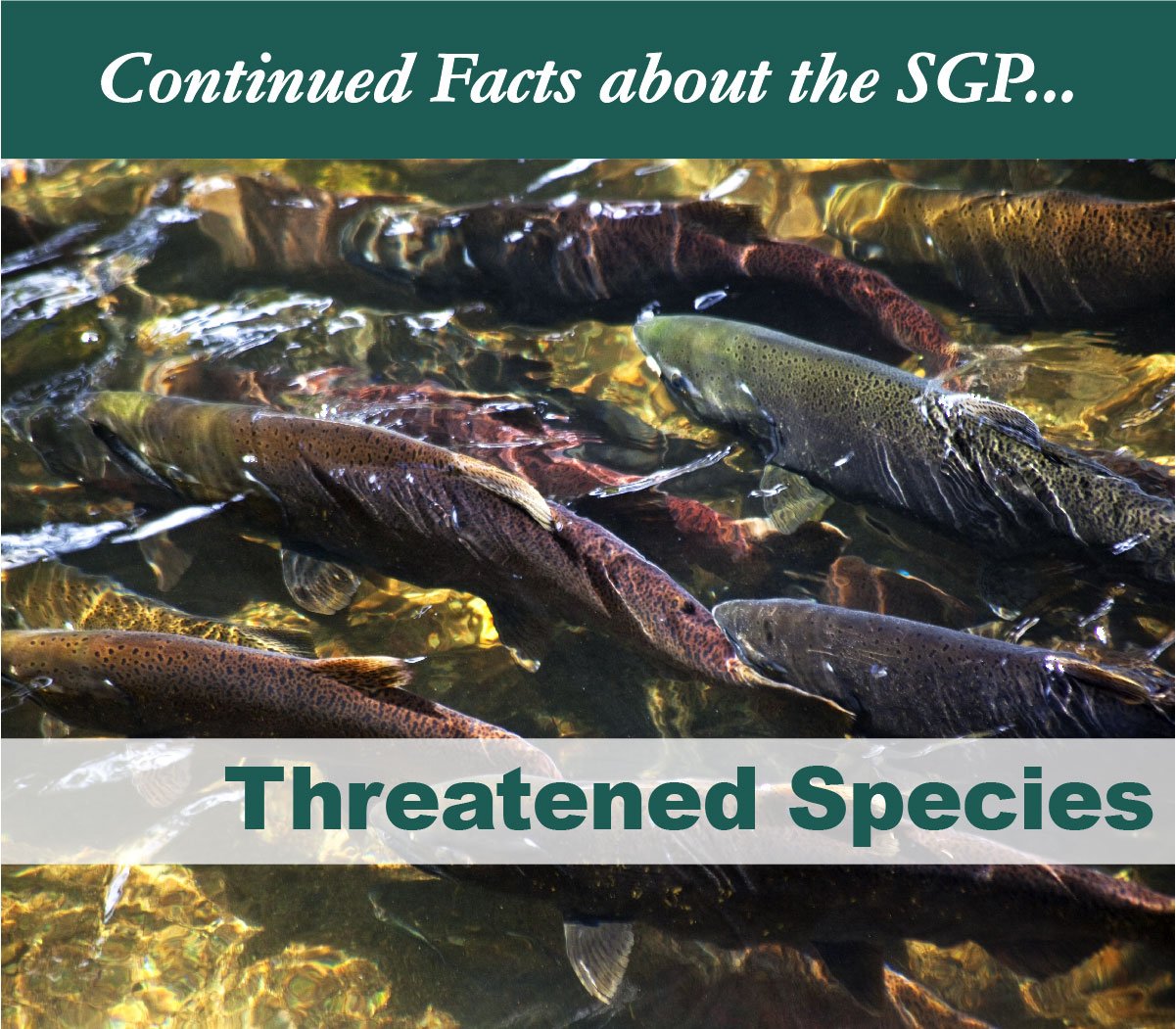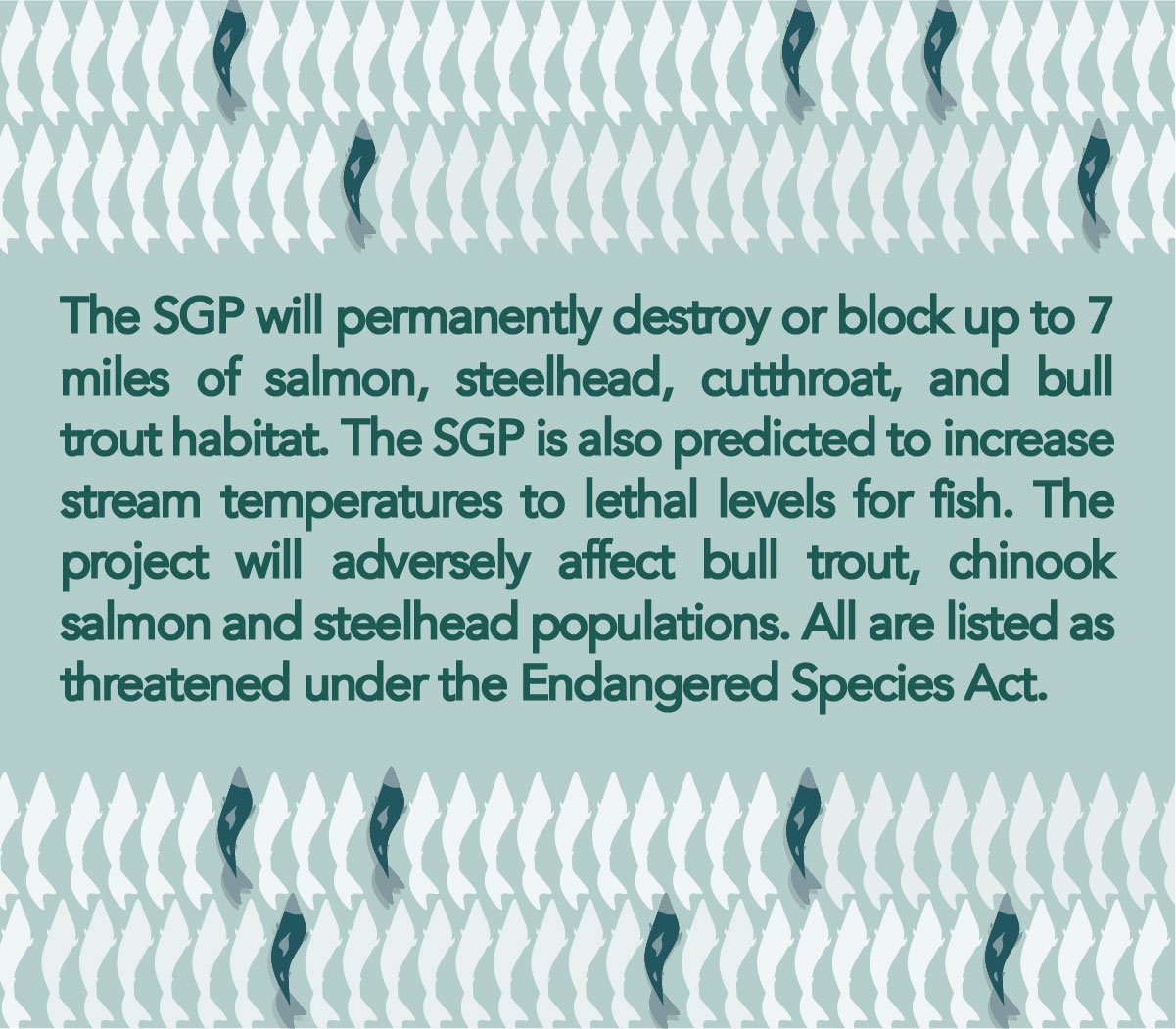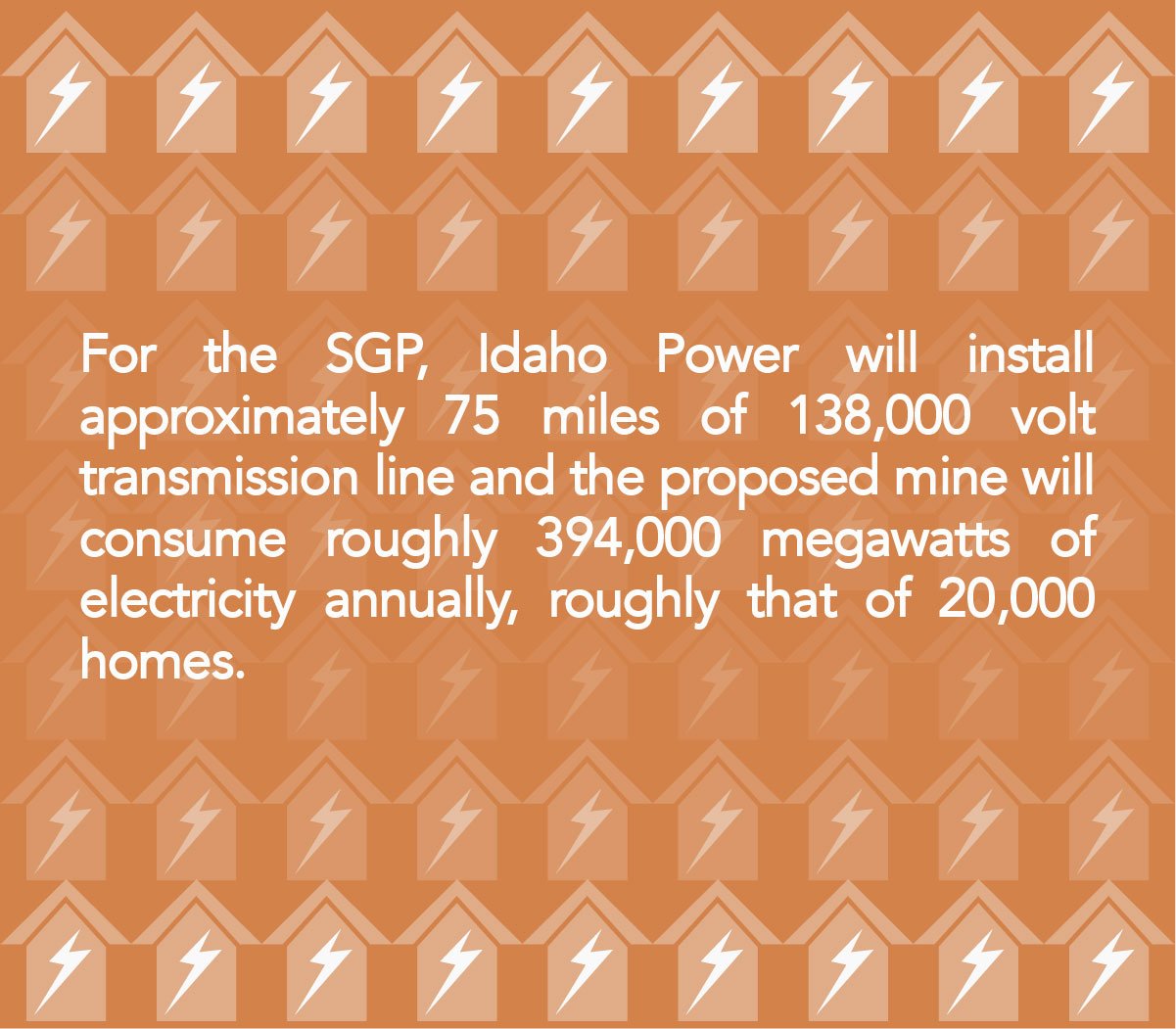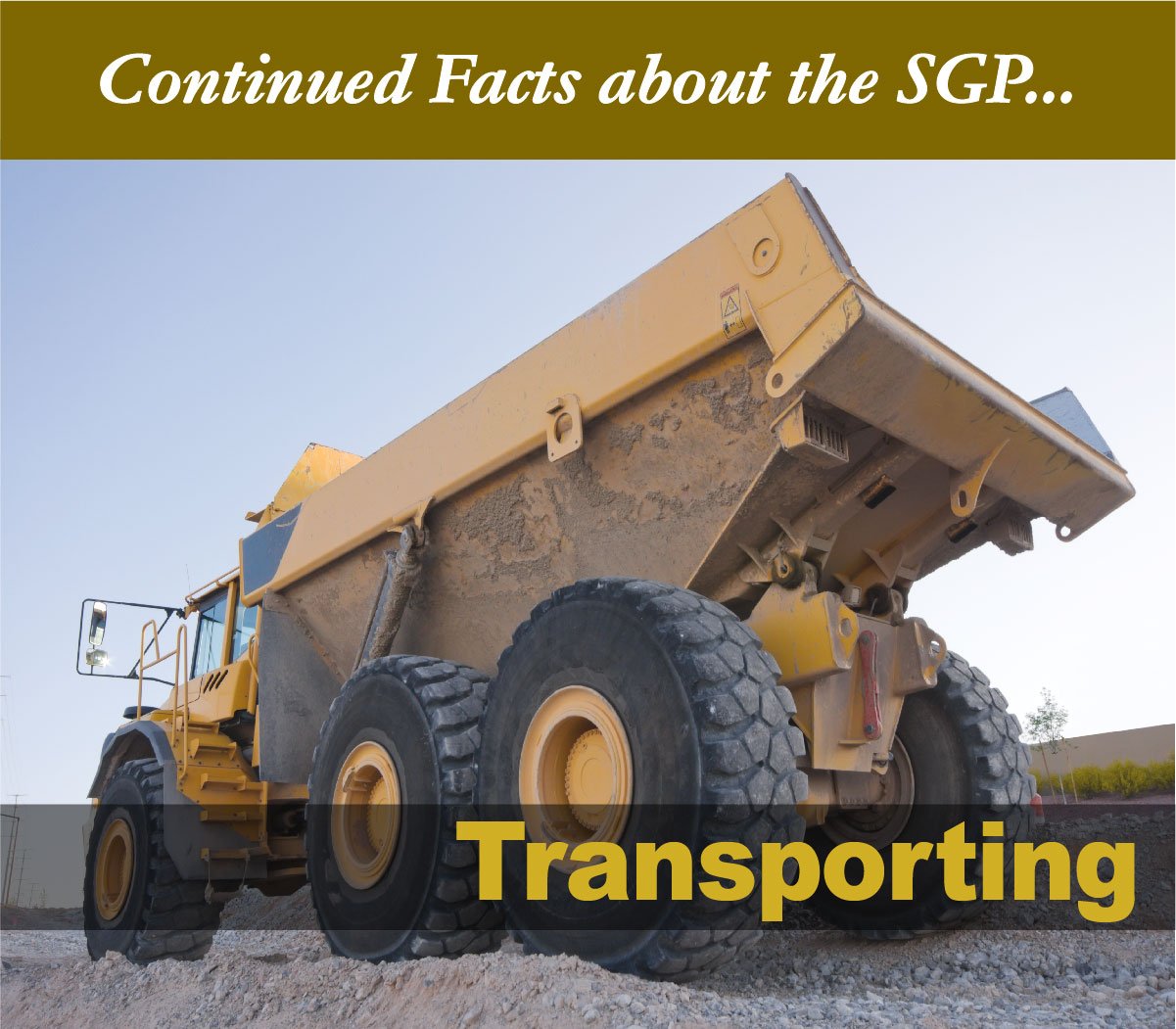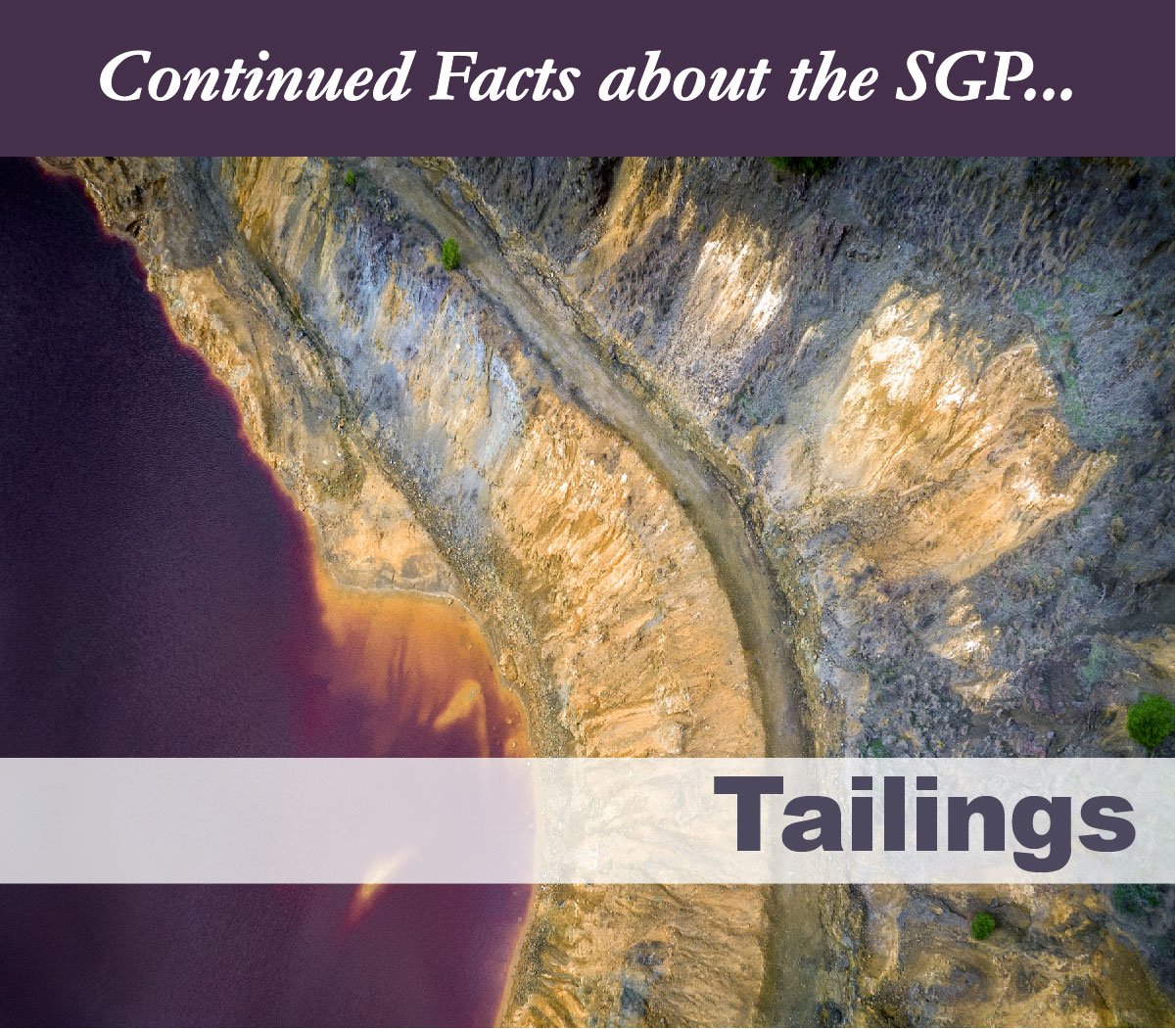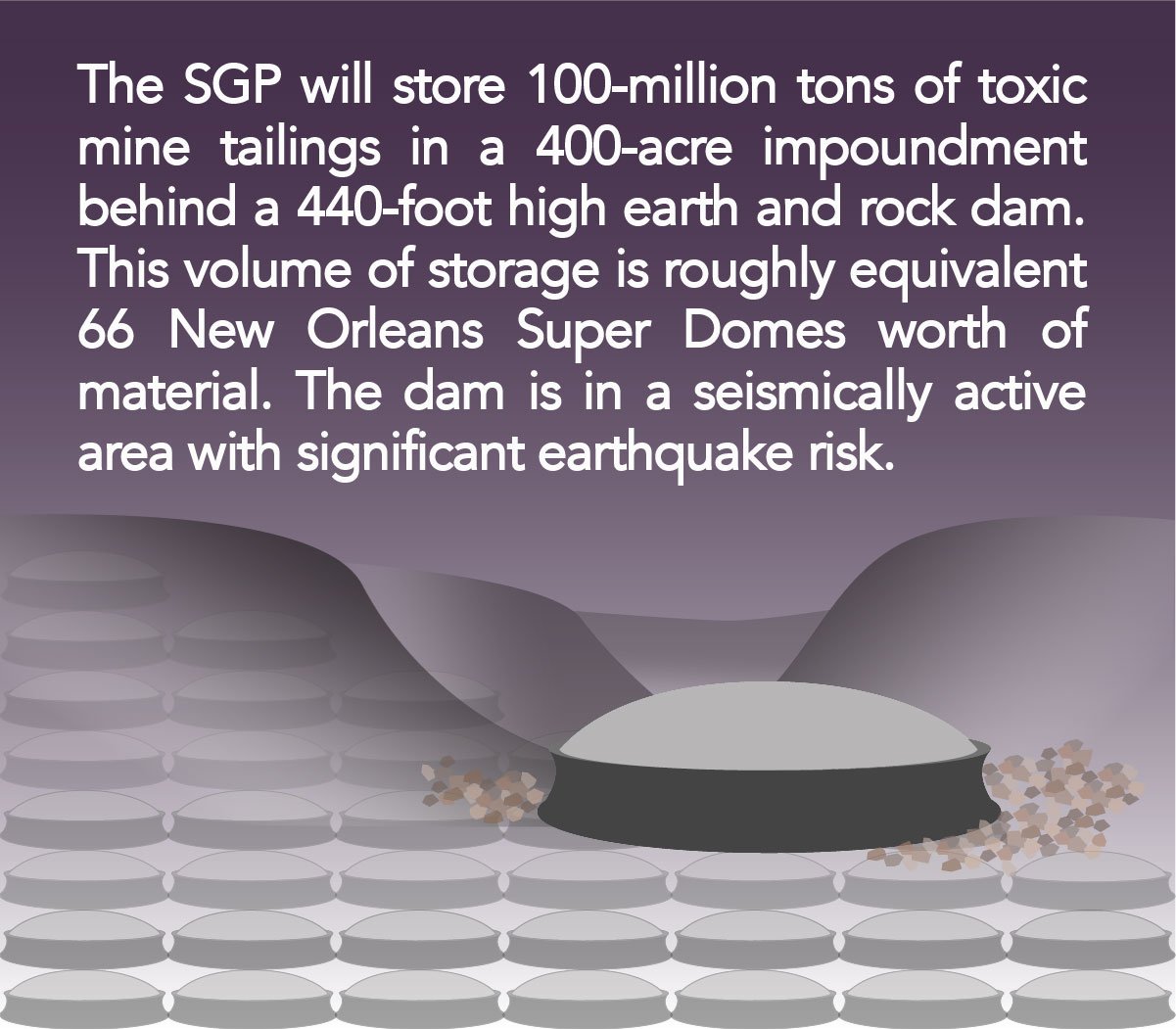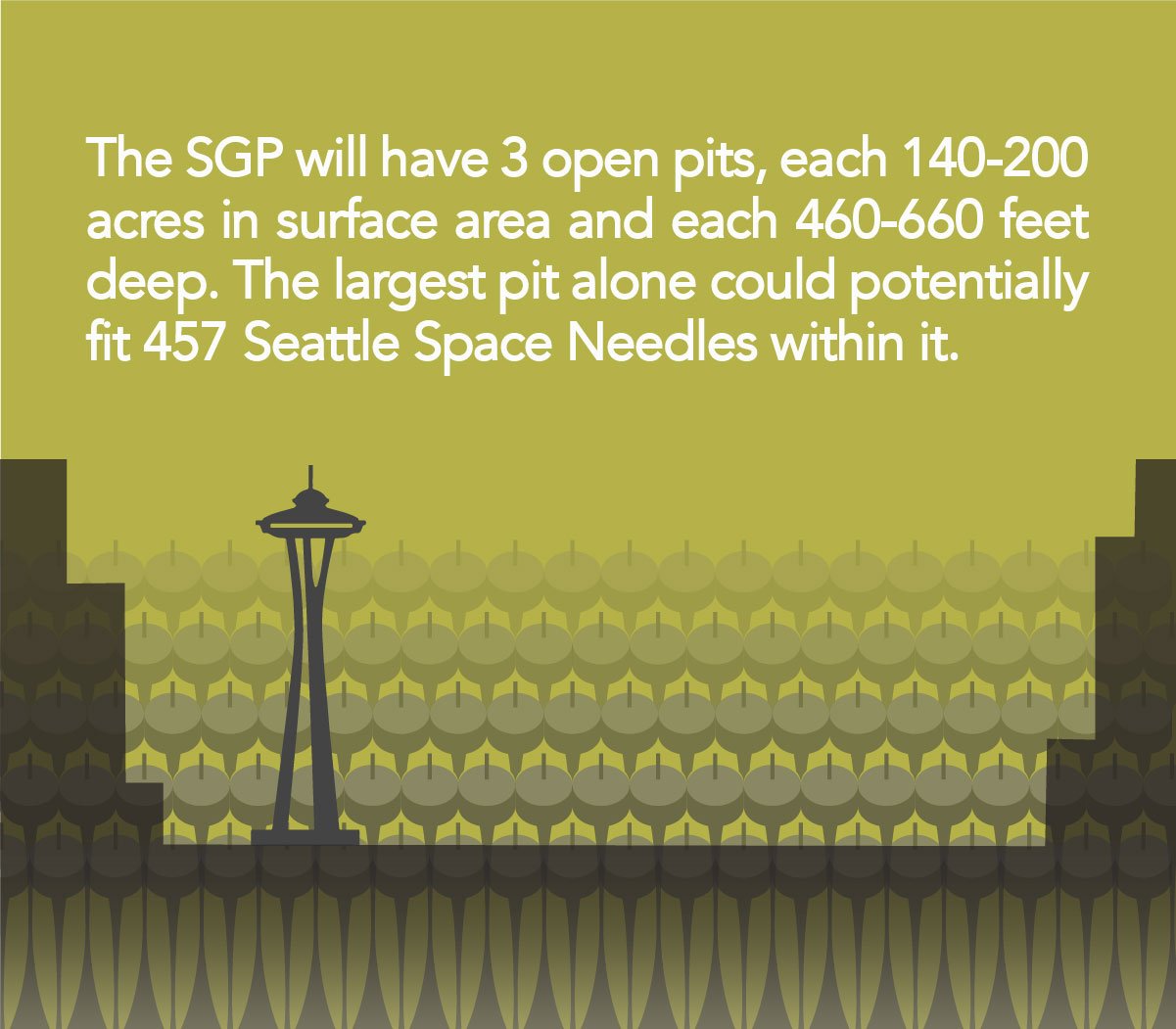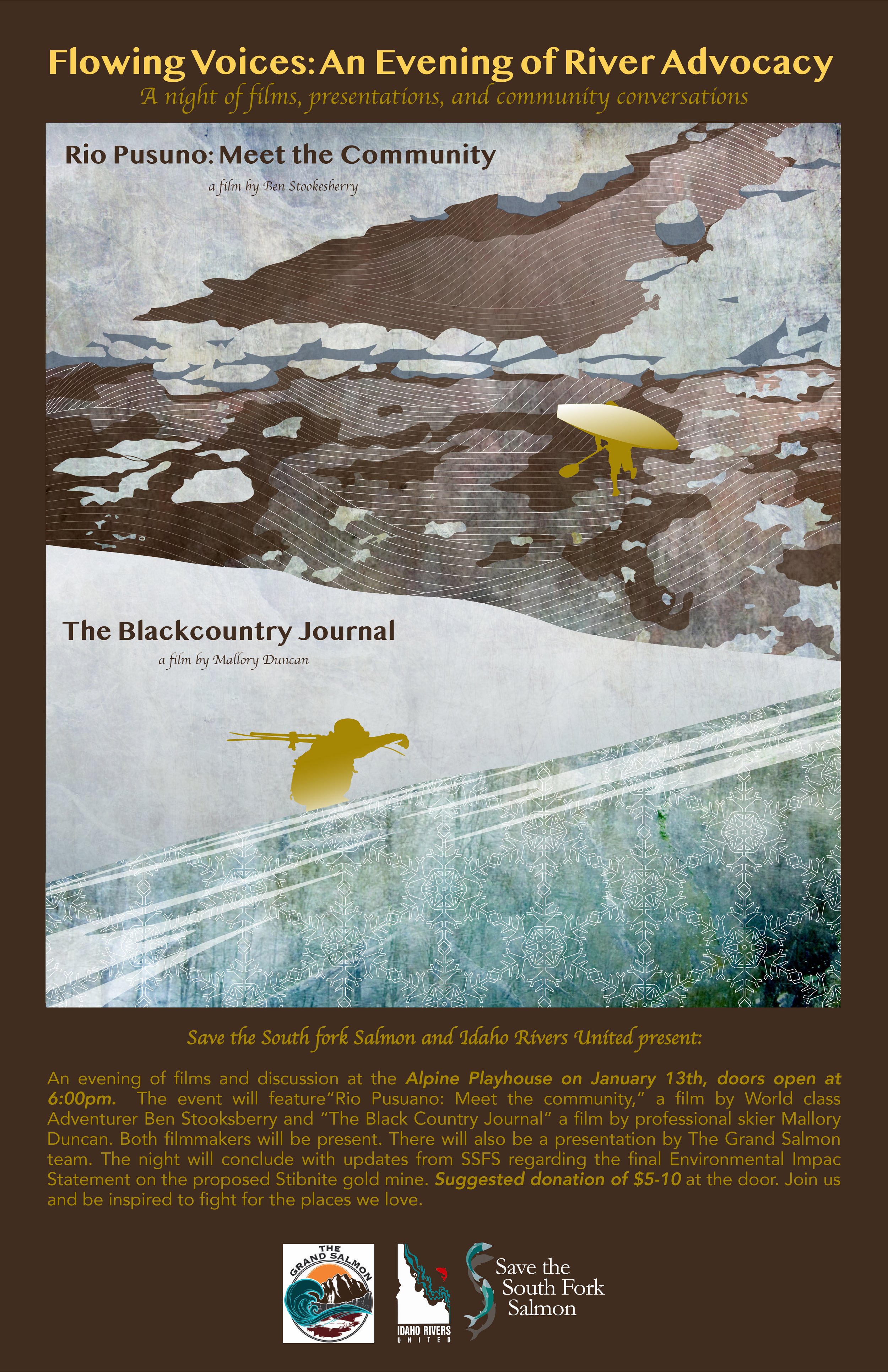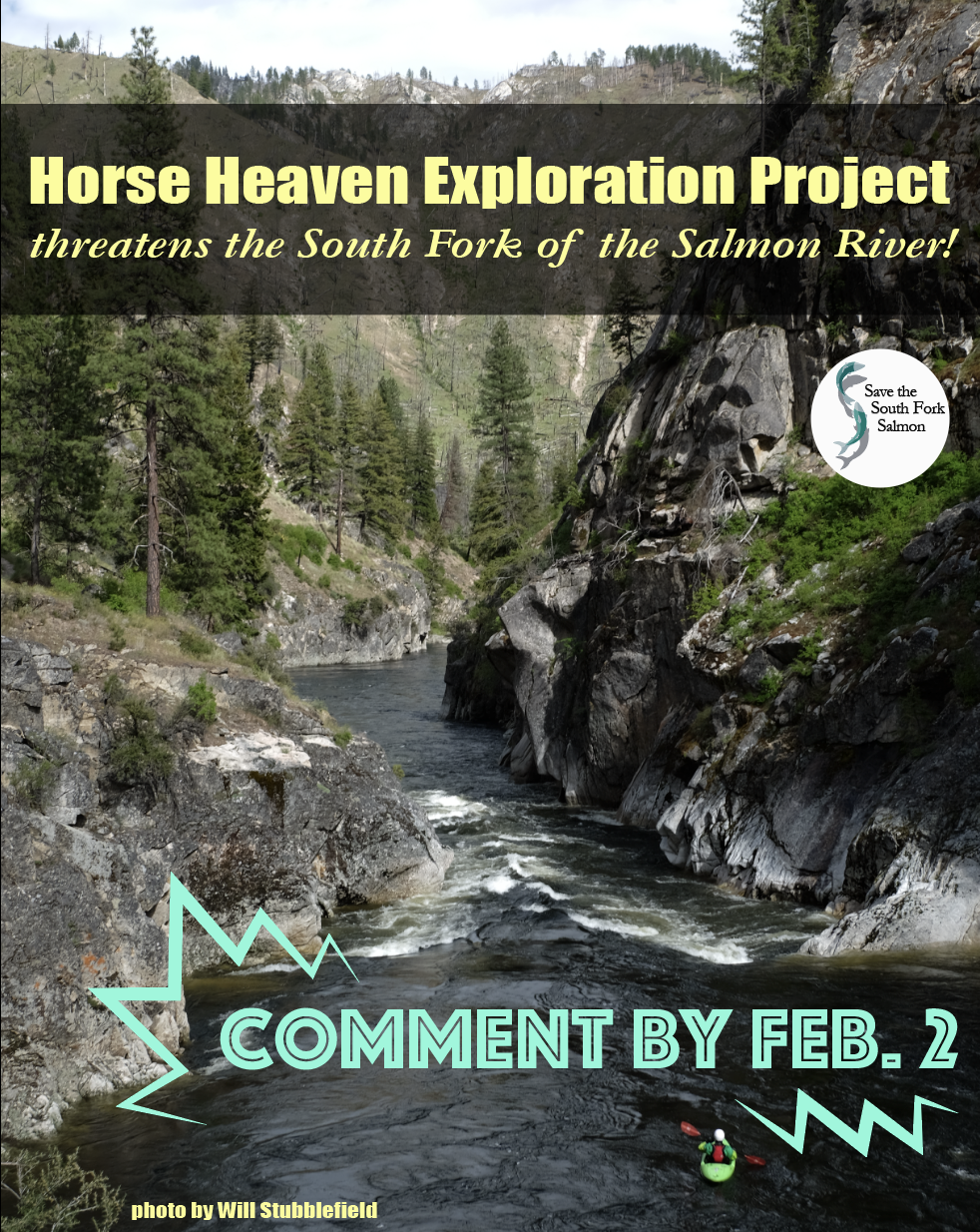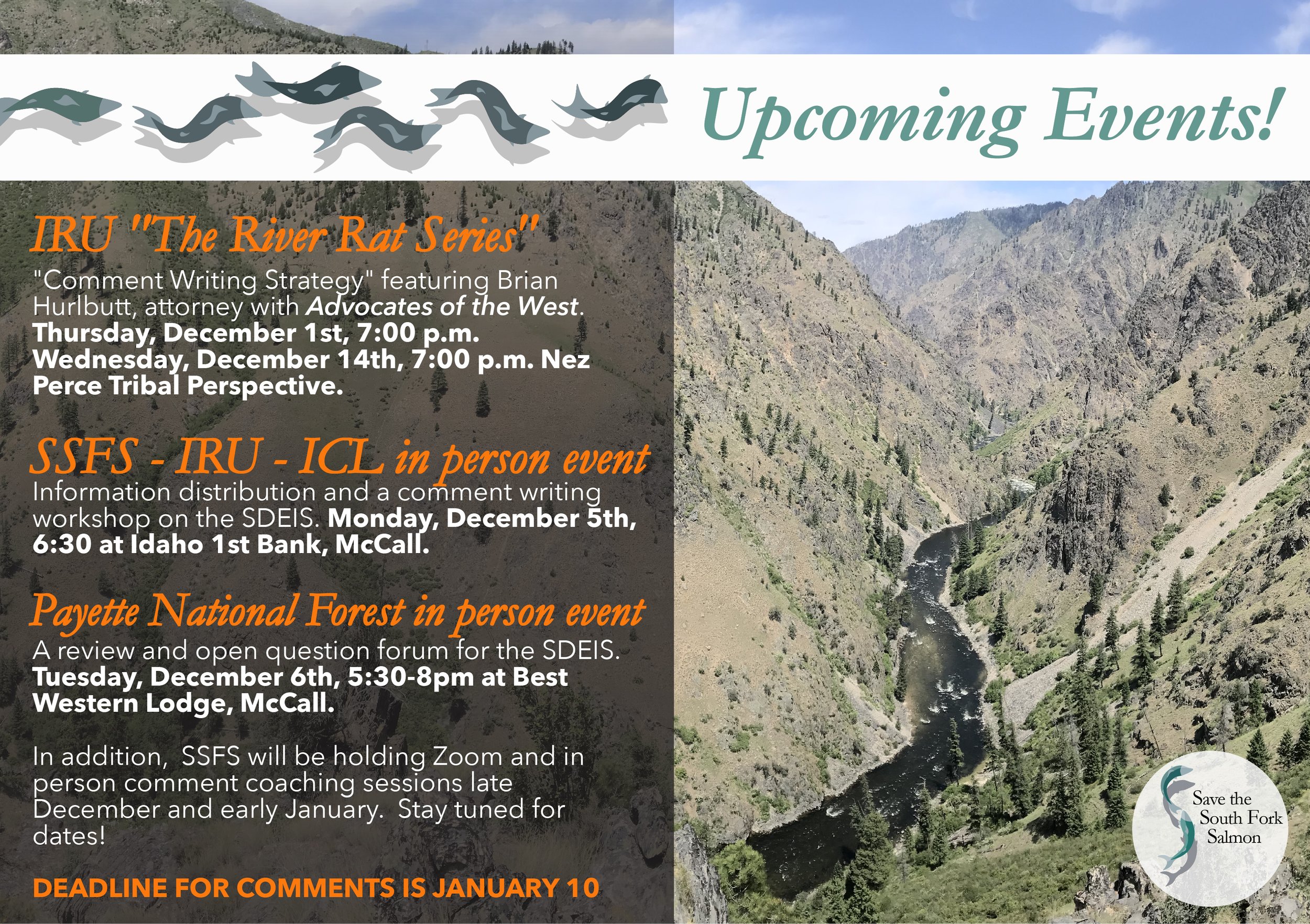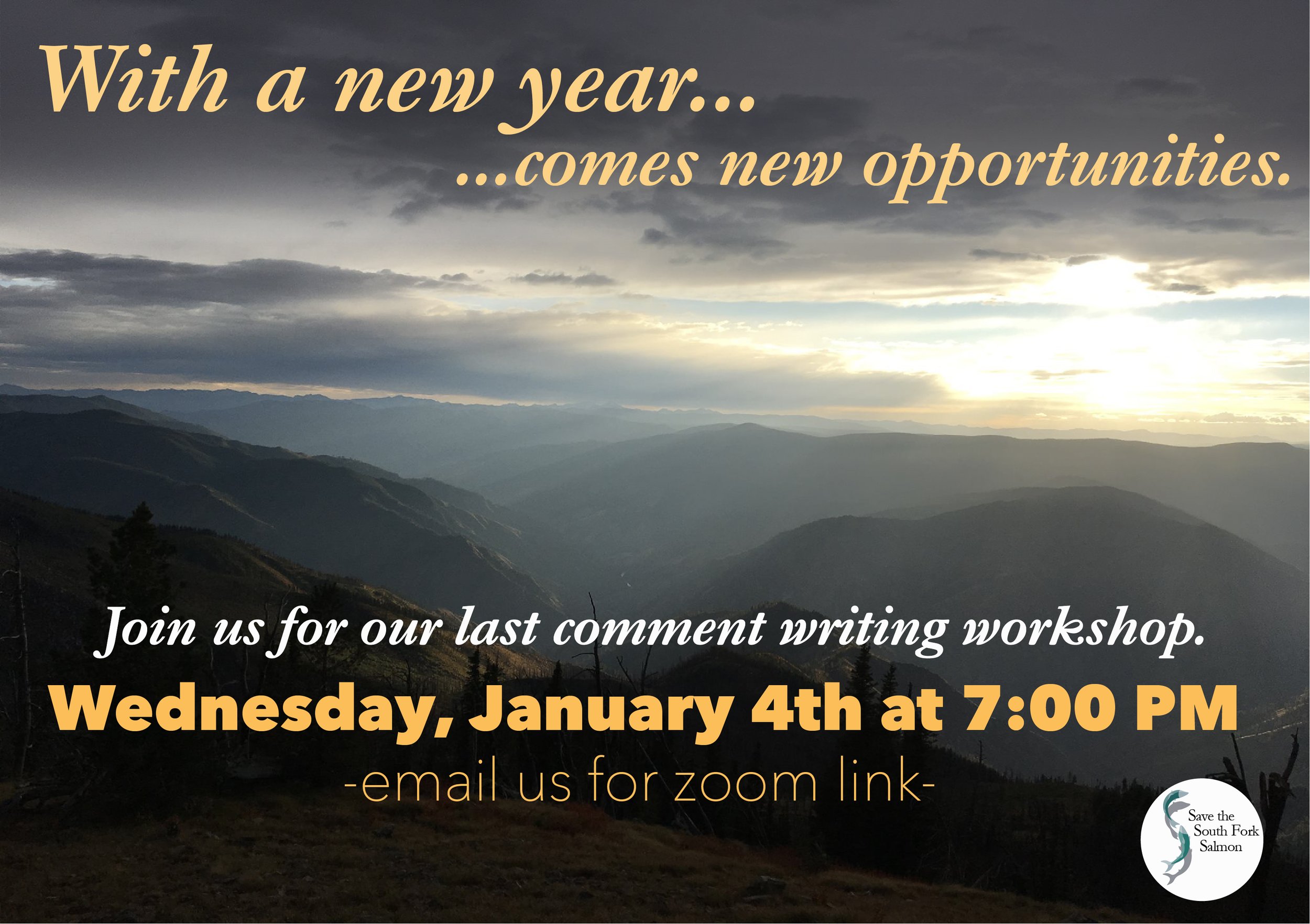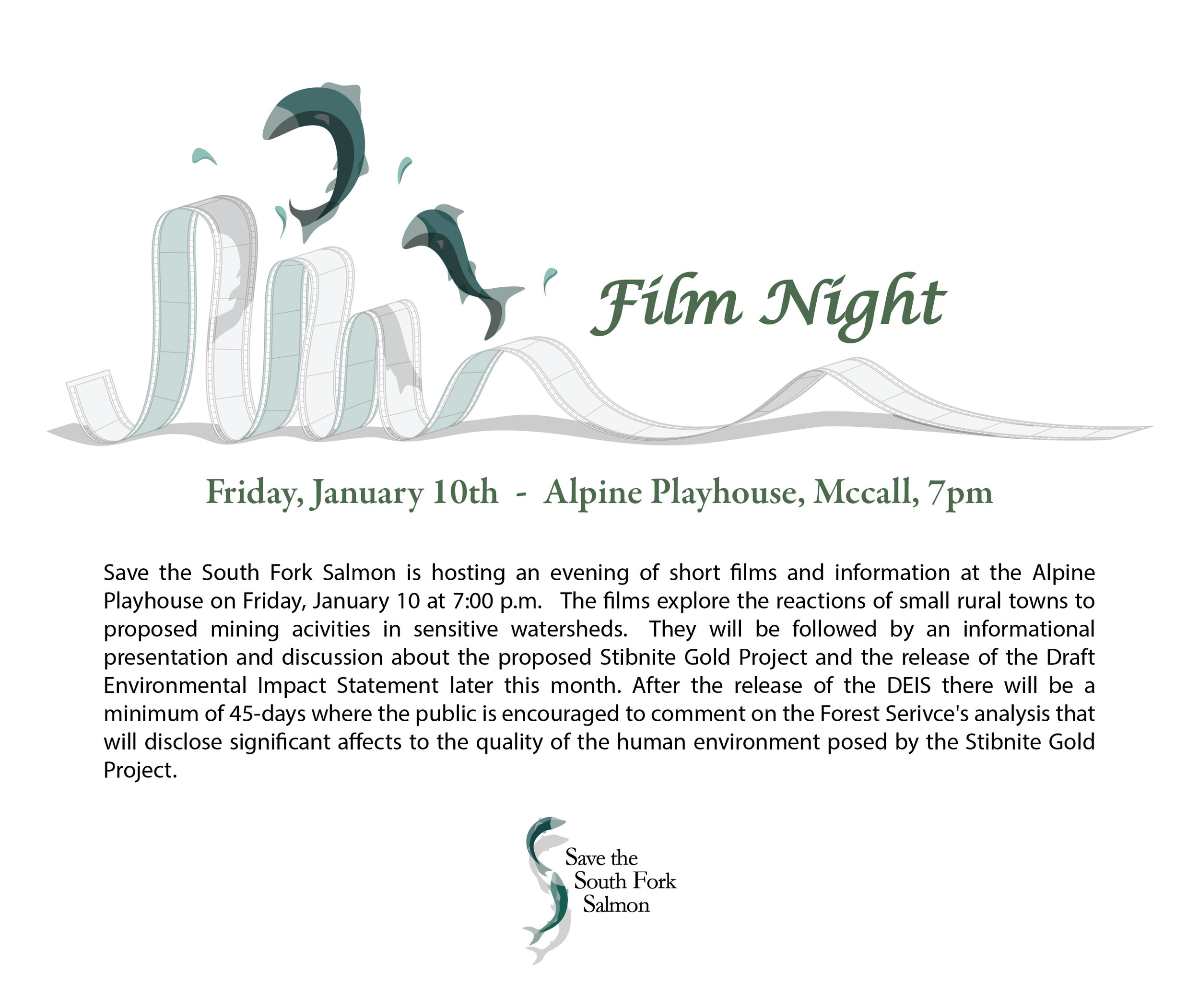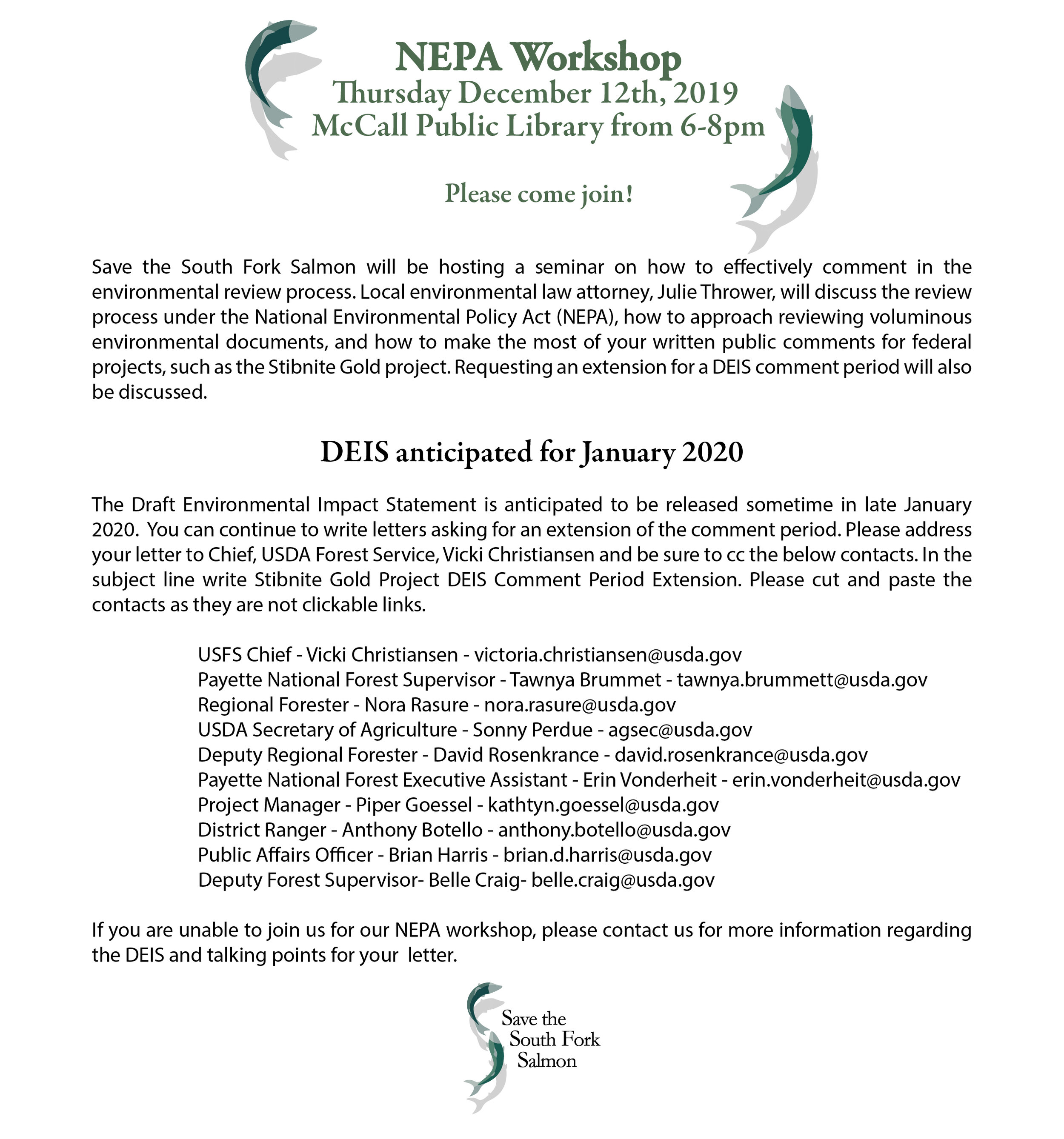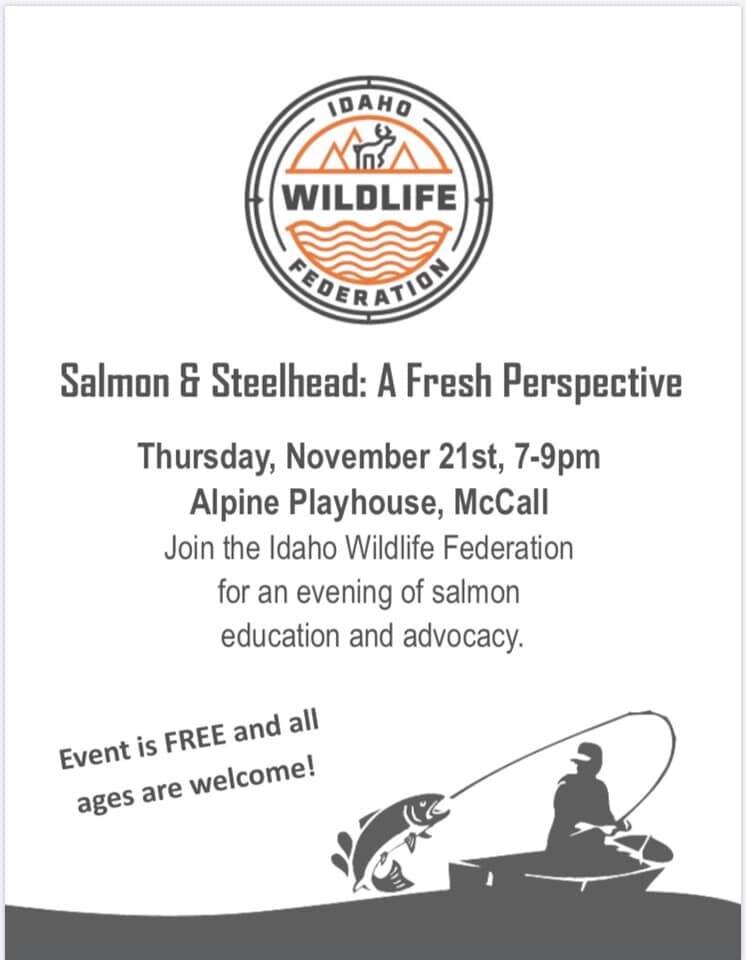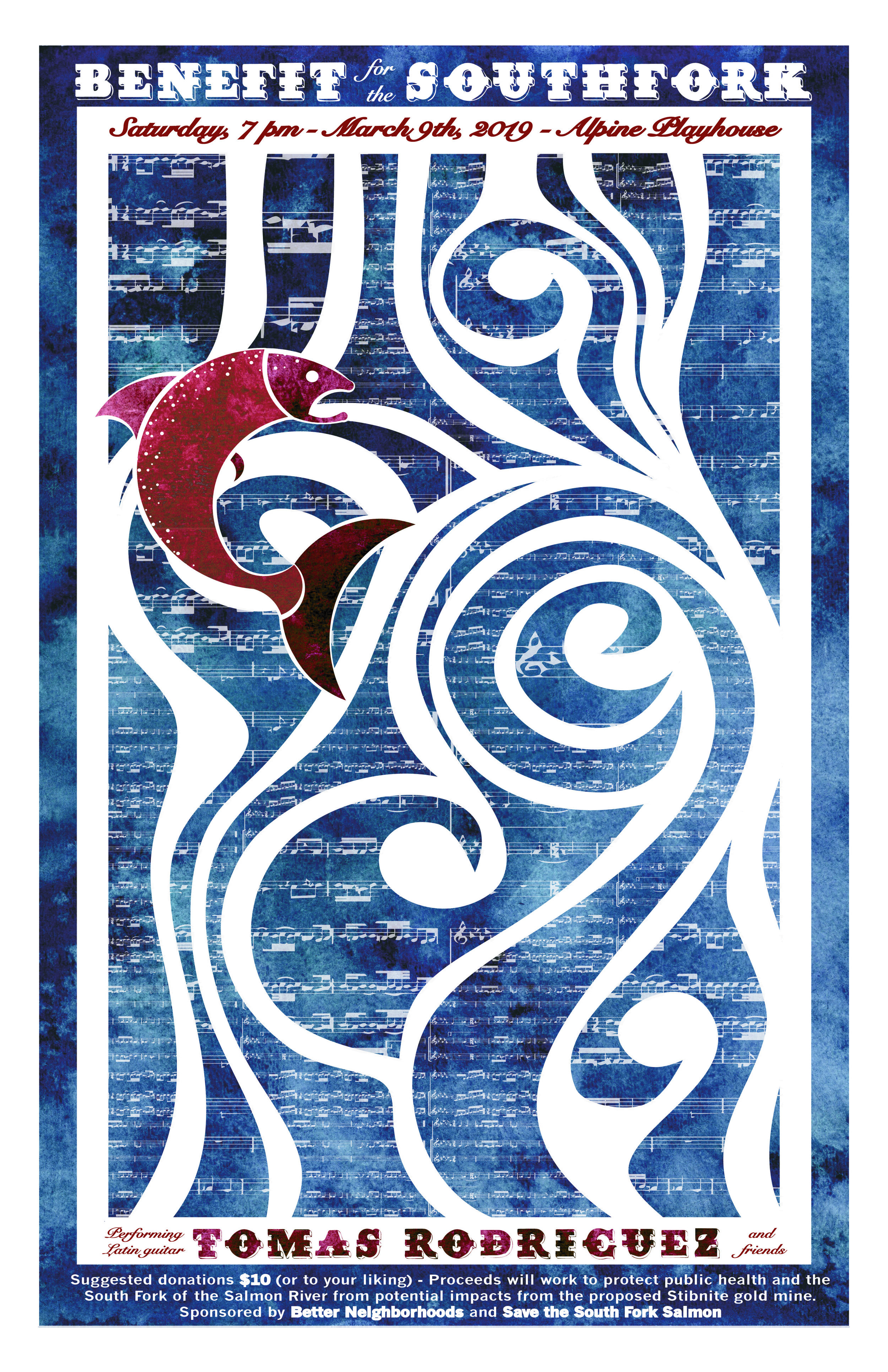There is still hope in our fight to stop the Stibnite Gold Project!
Keep scrolling for upcoming events and updates…
Who we are and what we do…
Save the South Fork Salmon (SSFS) is a community-based, all-volunteer organization headquartered in West Central Idaho. Our members cherish the mountains, the clean air and water, the fish, wildlife, plants and culture that make up our ecosystem. SSFS works to expose the dangers to the South Fork of the Salmon River ecosystem by the proposed reopening of the Stibnite gold mine by Perpetua Resources (formerly Midas Gold). We provide factual information about the ecosystem and the environmental and socio-economic threats posed by new mining at the headwaters of this delicate watershed. We focus on protecting public health, the river, the fish and the watershed by actively participating in the ongoing permitting processes. In addition we facilitate public comment in the National Environmental Policy Act process( NEPA) to ensure all laws and regulations are followed. To learn more about the South Fork Salmon River and the threat that the Stibnite Gold Project (SGP) poses to these headwaters, click on the link below.
“As a citizen of the Nez Perce, or Nimiipuu, which means the people, I look at gold mining as a symbol of broken promises….In 1860 gold was discovered, and thousands of prospectors flooded across our borders in violation of the treaty, damaging our sacred places and natural resources and causing unspeakable injury to our people... A century and a half later, the promise of gold once again threatens our homeland and way of life. For us, the Nimiipuu, the value of the land, fish and wildlife will always be worth more than gold.”
– Marcie Carter, Nez Perce Tribal member
“The Stibnite Gold Project will permanently scar thousands of acres of public land. Midas Gold does not own all this land. The Payette National Forest does not own this land. This land belongs equally to every citizen. The Payette National Forest’s responsibility is wise stewardship of the public’s land — your land.”
– Charles Ray, founding member of SSFS
Stop proposed mining from threatening our rivers

Current Updates
Some answers about antimony.
Antimony has become a driving force in the Stibnite Gold Project but there is a lot of misleading information being said about the mineral and it’s importance. Here are some clarifying details about antimony from our Stibnite Coalition partners at ICL. Click on the link below to learn more.
FS Releases Final Record of Decision! See what SSFS has to say about it.
On Friday, January 3, 2025, the U.S. Forest Service released its Final Record of Decision for the Stibnite Gold Project near McCall in Valley County, Idaho. While the Decision checks another box in the long list of permits necessary to proceed with new mining activities at Stibnite, significant federal and state permits still have not been issued. Nonetheless, the Forest Service has engaged in a radical and egregious breach of trust in managing public resources, with huge impacts to the environment…
Continue to read our LTE to the Star News by clicking the link below…
Recent News
SSFS Status Update - Sept. 18, 2024
See our newest status update on the Stibnite Gold Project and see how you can get involved!
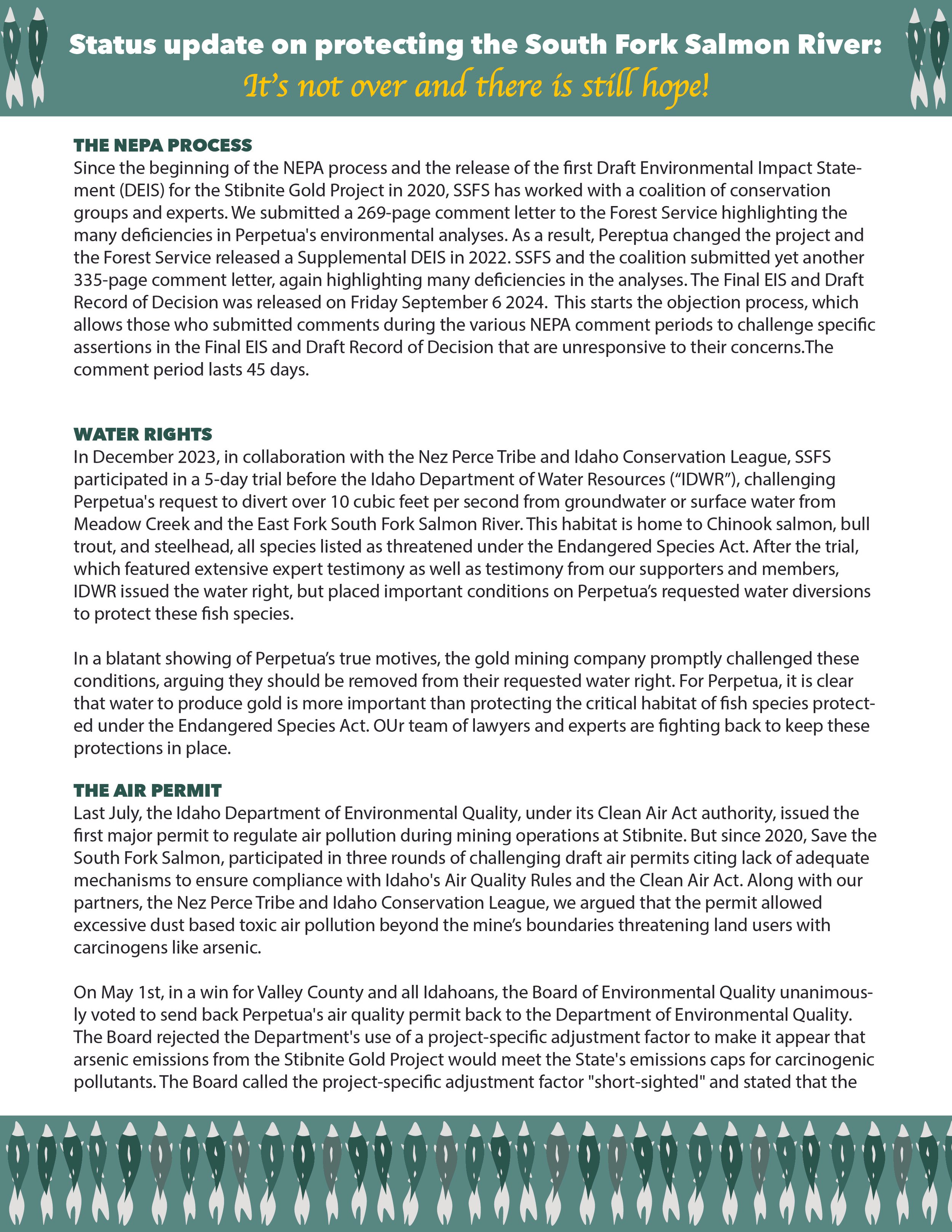

Top reasons for locals to ask the City of McCall to OPPOSE the Stibnite Mine! Write a letter today!
Continue to make waves by writing a letter to your local public officials and express your deep concerns over the Stibnite Gold Project. Here is what you might consider saying and who you might contact…
THE FEIS AND DRAFT RECORD OF DECISION IS OUT!
On Friday, September 6, 2024 the Forest Service released the Final EIS and Draft Record of Decision for the Stibnite Gold Project. This permitting milestone does not approve mining activity at Stibnite. In fact, with ongoing legal challenges to other key permits--the air quality permit, water rights protest, and Clean Water Act Section 401 water quality certification--the mining plan as envisioned by the Forest Service is unlikely to proceed any time in the near future.
To read our full press release, click on the link below.
TO VIEW THE FEIS CLICK ON THE LINK BELOW
Forest Service withdraws approval of Perpetua Resources’ Burntlog Route Geophysical Investigations Project - July 11, 2024
“On July 11, 2024, the Boise National Forest released a letter to the general public announcing that the Forest Service has withdrawn its approval of Perpetua Resources’ Burntlog Route Geophysical Investigations Project.” Read more from this IRU update.
Fantastic News! SGP Air Permit has been invalidated! May 2, 2024
The Idaho Board of Environmental Quality has invalidated the Stibnite Gold Project air permit.
This is a big win for the South Fork Salmon River watershed and for clean air and public health in Idaho. The now defunct air permit would have allowed the proposed gold mine to emit massive amounts of arsenic-laden dust in quantities that exceed state law limits designed to minimize exposure to carcinogens.
The decision rejects Idaho DEQ's "creative" math, which unlawfully dilutes the apparent levels of carcinogenic air pollution that could be emitted by the proposed Stibnite Gold Project. According to the Board, Idaho DEQ "created a misleading risk analysis that greatly underestimates the actual cancer risk." In other words, Idaho's Air Quality Rules cannot be ransacked by mining interests that value profits over public health.
For the past two years, the Nez Perce Tribe, SSFS, and Idaho Conservation League have scrutinized, and then challenged the Stibnite Gold Project's first major permit. Yesterday's decision sends a critical component of Perpetua Resources' ill-conceived gold mine back to the drawing board.
We could not have done this without your support!
Air Quality Permit Update - March 15, 2024
We’d like to acknowledge the colossal effort put forth by the Idaho Conservation League, Save the South Fork Salmon and the Nez Perce Tribe appealing Perpetua Resource’s air quality permit and helping to protect Idaho’s clean air. This team and these organizations have been working hard to protect public health from arsenic and particulate pollution that the Stibnite Gold Project will emit. The hearing has been made and we are awaiting the decision. Stay tuned!
Past News
Backyard Problems report uses Stibnite as one of its case studies - Aug. 11,2023
Read the recent report from Backyard Problems illustrating the longstanding issues with mining in the United States and the concerns with the Stibnite Gold Project in particular.
“The Stibnite Gold Project exemplifies how damage from poorly-regulated mining is still causing harm today and into the future. Because of insufficient funding to address impacts from historical activities and operators, the site is caught in a vicious cycle where there are few options other than to accept industry’s offer to help with the cleanup, but only as a side project of what will be an enormously profitable gold mining operation. The Stibnite Area demonstrates the need for careful planning, rigorous environmental safeguards, bond amounts that reflect the true cost of cleanup, and funding for mine remediation to reduce our dependence on mining industry charity to clean up the mistakes of the past.”
Click on the link below to read more.
Seattle Times accounts EPA’s dissatisfaction with Perpetua’s air quality permit - Aug. 28, 2023
“The Environmental Protection Agency slammed an air quality permit for a proposed central Idaho gold mine issued by the Idaho Department of Environmental Quality, saying it is so lax that it might violate the federal Clean Air Act.”
Critical Issues
Concerns over Perpetua’s Air Quality Permit and why SSFS has petitioned it.
Last July, the Idaho Department of Environmental Quality, under its Clean Air Act authority, issued the Stibnite Gold Project’s first major permit to regulate air pollution emitted during mining operations. Since 2020, Save the South Fork Salmon, Inc., along with the Idaho Conservation League, the Nez Perce Tribe, and EPA, has participated in three rounds of draft permits, where issues were repeatedly raised about the permit’s lack of adequate mechanisms to ensure compliance with Idaho's Air Quality Rules and the Clean Air Act. When DEQ failed to address these concerns in the final permit, SSFS petitioned the State to review DEQ's actions. SSFS asserts that DEQ's handling of this permit was driven by politics–and not the best available science–to value industry profits over serious threats to public health and safety. The permit allows Perpetua Resources to endanger people near or traveling through the mine site by exposing them to toxic air pollutants. And the permit allows Perpetua Resources itself to decide when it has committed an air quality violation.
Horse Heaven GOld Project
The threat of gold mining in the South Fork Salmon River watershed continues with Canada-based Stallion Discoveries Corp.'s proposed Horse Heaven Gold Project, located directly north of the Stibnite Gold Project.
The Horse Heaven Exploration Project includes drilling 60 holes each up to 1,000 feet deep, using 30,000 gallons of water per day, and operating 24 hours a day and 7 days a week during the drilling season. The project borders roadless areas, impacts critical habitat for threatened and endangered species, and lies within the aboriginal lands of the Nez Perce Tribe. Traffic associated with fuel and hazardous material hauls on the Johnson Creek Road will only exacerbate impacts if the Stibnite Gold Project is approved. See link bellow to comment with the Forest Service.
Be a voice for the South Fork Salmon River. The watershed must not become the epicenter of a 21st century gold rush.
Water Rights Protest Continues
The Water Rights Protest continues before the Idaho Department of Water Resources. In December 2021, SSFS, the Nez Perce Tribe, and Idaho Conservation League protested Perpetua Resource’s application to appropriate and divert 9.6cfs of water from the East Fork of the South Fork. The water would primarily be used for ore processing. SSFS believes that the sheer volume of this appropriation will negatively impact the local public interest, including the health and viability of aquatic ecosystems in the East Fork South Fork Salmon River. A decision on a preliminary matter -- which will help guide the protest as it moves forward -- is expected later this summer.
SSFS and PARTNERS CHALLENGE PERPETUA’S AIR QUALITY PERMIT
With help from our technical experts and partner organizations we have continued to expose the flaws in Perpetua’s proposed plan to control toxic air emissions from the Stibnite Gold Project. Find out more about our efforts and read our joint letter with ICL, IRU, and Earthworks to the US Forest Service. Click on the links below.
WHAT ABOUT ANTIMONY, “Strategic Minerals” CLIMATE CHANGE AND THE” NEW MINING BOOM”?
Perpetua's latest attempt to portray their project as contributing to the common good (rather than just the investors) centers on the production of antimony as a byproduct. Their claim that this antimony is needed to enable a transition to renewable energy is little more than “greenwashing” intended to encourage public support of a gold mine having major detrimental environmental and economic impacts. To learn more, click on the link below.
What is Greenwashing?
One of our own founding members, Judy Anderson, explains it well in her opinion piece in our local Star News publication. To learn more, click on the links below.
THE MINING BOOM AND MINING LAW REFORM
With critical minerals demand rising to power the new technologies of the clean energy economy, we must ensure that our critical mineral supply chains are sustainable, secure, and held to the highest environmental, equity, and human rights standards. Reforming the 1872 Mining Law that has governed hardrock mining for 150 years is critical to ensuring that any minerals sourced through mining are done in the most sustainable way possible.
In addition, there has been a Huge win for mining law reform in the Ninth Circuit Court of Appeals! On May 12, 2022, the Ninth Circuit ruled that the Forest Service could not assume the validity of unpatented mining claims to justify permanent occupation of those claims with millions of tons of mine waste. Because the 1872 Mining Law allows exlcusive possession and enjoyment of the surface of a mining claim only if a valuable mineral deposit exists, the Forest Service misconstured the law when it approved the indefinite storage of mine waste on national forest land where no valuable minerals had been discovered. SSFS is watching this case closely because a similar factual scenario is present for the Stibnite Gold Project.











